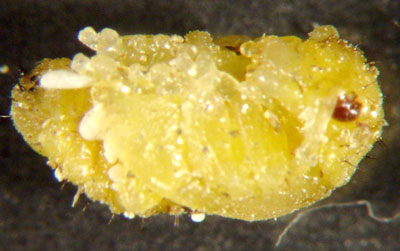Viburnum leaf
beetle home
Back to How to identify viburnum leaf beetles
Logo images by Kent Loeffler, Paul Weston & Craig Cramer
|
In early to mid-June, when larvae reach about 10 to 11 mm long, the they crawl down the shrub, enter the soil, and pupate. This is a non-feeding stage between larvae and adult where the pupae develop within a cocoon, similar to the lifecycle of butterflies.
Pupae are very hard to find. They need moist soil. If it's too wet or too dry, the pupae don't seem to survive as well.
In early July, the adult beetles emerge from the soil and start feeding on viburnum foliage.

Larger image. Photo by Paul Weston
Pupae live briefly in the soil and are difficult to spot.
© Copyright, Department of Horticulture, Cornell University.
Project coordinator: Lori Brewer, ljb7@cornell.edu
Website design: Craig Cramer cdc25@cornell.edu
Mention of trade names and commercial products is for educational purposes; no discrimination is intended and no endorsement by Cornell Cooperative Extension or Cornell University is implied. Pesticide recommendations are for informational purposes only and manufacturers' recommendations change. Read the manufacturers' instructions carefully before use. Cornell Cooperative Extension and Cornell University assumes no responsibility for the use of any pesticide or chemicals. Some of the links provided are not maintained by Cornell Cooperative Extension and Cornell University. Cornell Cooperative Extension and Cornell University are not responsible for information on these websites. They are included for information purposes only and no endorsement by Cornell Cooperative Extension or Cornell University is implied. Cornell Cooperative Extension provides equal program and employment opportunities.
|